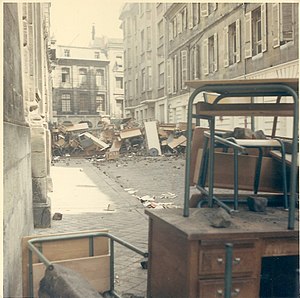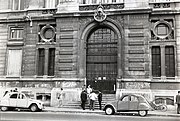Protesti u Francuskoj u maju 1968. — разлика између измена
. |
(нема разлике)
|
Верзија на датум 9. јануар 2020. у 07:06
Један корисник управо ради на овом чланку. Молимо остале кориснике да му допусте да заврши са радом. Ако имате коментаре и питања у вези са чланком, користите страницу за разговор.
Хвала на стрпљењу. Када радови буду завршени, овај шаблон ће бити уклоњен. Напомене
|
| Protesti u Francuskoj maja 1968. | |||
|---|---|---|---|
| Deo Protesta iz 1968. | |||
 | |||
| Datum | 2. maj – 23. jun 1968 (1 mesec i 3 sedmice) | ||
| Lokacija | Francuska | ||
| Metodi | Occupations, wildcat strikes, general strikes | ||
| Rezultiralo u | Snap legislative election | ||
| Strane u civilnom sukobu | |||
| Vodeće figure | |||
| |||
Beginning in May 1968, a period of civil unrest occurred throughout France, lasting some seven weeks and punctuated by demonstrations, general strikes, and the occupation of universities and factories. At the height of events, which have since become known as May 68, the economy of France came to a halt.[1] The protests reached such a point that political leaders feared civil war or revolution; the national government briefly ceased to function after President Charles de Gaulle secretly fled France to Germany at one point. The protests spurred movements worldwide, with songs, imaginative graffiti, posters, and slogans.[2][3]
The unrest began with a series of student occupation protests against capitalism, consumerism, American imperialism and traditional institutions. Heavy police repression of the protesters led France's trade union confederations to call for sympathy strikes, which spread far more quickly than expected to involve 11 million workers, more than 22% of the total population of France at the time.[1] The movement was characterized by spontaneous and decentralized wildcat disposition; this created a contrast and at times even conflict internally amongst the trade unions and the parties of the left.[1] It was the largest general strike ever attempted in France, and the first nationwide wildcat general strike.[1][4]
Events of May
Student strikes

Following months of conflicts between students and authorities at the Nanterre campus of the University of Paris (now Paris Nanterre University), the administration shut down the university on 2 May 1968.[5] Students at the Sorbonne campus of the University of Paris (today Sorbonne University) in Paris met on 3 May to protest against the closure and the threatened expulsion of several students at Nanterre.[6] On Monday, 6 May, the national student union, the Union Nationale des Étudiants de France (UNEF)—still the largest student union in France today—and the union of university teachers called a march to protest against the police invasion of Sorbonne. More than 20,000 students, teachers and supporters marched towards the Sorbonne, still sealed off by the police, who charged, wielding their batons, as soon as the marchers approached. While the crowd dispersed, some began to create barricades out of whatever was at hand, while others threw paving stones, forcing the police to retreat for a time. The police then responded with tear gas and charged the crowd again. Hundreds more students were arrested.
High school student unions spoke in support of the riots on 6 May. The next day, they joined the students, teachers and increasing numbers of young workers who gathered at the Arc de Triomphe to demand that:
- All criminal charges against arrested students be dropped,
- the police leave the university, and
- the authorities reopen Nanterre and Sorbonne.
Negotiations broke down, and students returned to their campuses after a false report that the government had agreed to reopen them, only to discover the police still occupying the schools. This led to a near revolutionary fervor among the students.
On Friday, 10 May, another huge crowd congregated on the Rive Gauche. When the Compagnies Républicaines de Sécurité again blocked them from crossing the river, the crowd again threw up barricades, which the police then attacked at 2:15 in the morning after negotiations once again floundered. The confrontation, which produced hundreds of arrests and injuries, lasted until dawn of the following day. The events were broadcast on radio as they occurred and the aftermath was shown on television the following day. Allegations were made that the police had participated in the riots, through agents provocateurs, by burning cars and throwing Molotov cocktails.[7]
Vidi još
Reference
- ^ а б в г „Situationist International Online”.
- ^ „Mai 68 - 40 ans déjà”.
- ^ DeRoo, Rebecca J. (2014). The Museum Establishment and Contemporary Art: The Politics of Artistic Display in France after 1968. Cambridge University Press. ISBN 9781107656918.
- ^ Erlanger, Steven (29. 4. 2008). „May 1968 - a watershed in French life”. New York Times. Приступљено 31. 8. 2012.
- ^ Rotman, pp. 10–11; Damamme, Gobille, Matonti & Pudal, ed., p. 190.
- ^ Damamme, Gobille, Matonti & Pudal, ed., p. 190.
- ^ „Michel Rocard”. Le Monde.fr. Архивирано из оригинала 22. 10. 2007. г. Приступљено 21. 4. 2007.
Literatura
- Damamme, Dominique; Gobille, Boris; Matonti, Frédérique; Pudal, Bernard, ур. (2008). Mai-juin 68 (на језику: French). Éditions de l'Atelier. ISBN 978-2708239760.
- Rotman, Patrick (2008). Mai 68 raconté à ceux qui ne l'ont pas vécu (на језику: French). Seuil. ISBN 978-2021127089.
- Abidor, Mitchell. May Made Me. An Oral History of the 1968 Uprising in France (interviews).
- Adair, Gilbert. The Holy Innocents (novel).
- Bourg, Julian. From Revolution to Ethics: May 1968 and Contemporary French Thought.
- Casevecchie, Janine. MAI 68 en photos:, Collection Roger-Viollet, Editions du Chene - Hachette Livre, 2008.
- Castoriadis, Cornelius with Claude Lefort and Edgar Morin. Mai 1968: la brèche.
- Cliff, Tony and Ian Birchall. France – the struggle goes on. Full text at marx.org
- Cohn-Bendit, Daniel. Obsolete Communism: The Left-Wing Alternative.
- Dark Star Collective. Beneath the Paving Stones: Situationists and the Beach, May 68.
- DeRoo, Rebecca J. The Museum Establishment and Contemporary Art: The Politics of Artistic Display in France after 1968.
- Feenberg, Andrew and Jim Freedman. When Poetry Ruled the Streets.
- Ferlinghetti, Lawrence. Love in the Days of Rage (novel).
- Gregoire, Roger and Perlman, Fredy. Worker-Student Action Committees: France May '68. PDF of the text
- Harman, Chris. The Fire Last Time: 1968 and After. London: Bookmarks, 1988.
- Jones, James. The Merry Month of May (novel).
- Knabb, Ken. Situationist International Anthology.
- Kurlansky, Mark. 1968: The Year That Rocked The World.
- Marcus, Greil. Lipstick Traces: A Secret History of the 20th Century.
- Emile Perreau-Saussine, "Liquider mai 68?", in Les droites en France (1789–2008), CNRS Editions, 2008, p. 61-68, PDF
- Plant, Sadie. The Most Radical Gesture: The Situationist International in a Postmodern Age.
- Quattrochi, Angelo; Nairn, Tom (1998). The Beginning of the End. Verso Books. ISBN 978-1859842904.
- Ross, Kristin. May '68 and its Afterlives.
- Schwarz, Peter. '1968: The general strike and the student revolt in France'. 28 May 2008. Retrieved 12 June 1010. World Socialist Web Site.
- Seale, Patrick and Maureen McConville. Red Flag/Black Flag: French Revolution 1968.
- Seidman, Michael. The Imaginary Revolution: Parisian Students and Workers in 1968 (Berghahn, 2004).
- Singer, Daniel. Prelude To Revolution: France In May 1968.
- Staricco, Juan Ignacio. The French May and the Shift of Paradigm of Collective Action.
- Touraine, Alain. The May Movement: Revolt and Reform.
- The Atelier Popularie. Beauty Is in the Street: A Visual Record of the May 68 Uprising.
- Maclean, M. (2002). Economic Management and French Business: From de Gaulle to Chirac. Palgrave Macmillan UK. ISBN 978-0-230-50399-1.
- 1944-, Viénet, René (1992). Enragés and situationists in the occupation movement, France, May '1968. New York: Autonomedia. ISBN 0936756799. OCLC 27424054.
- Singer, Daniel (2002). Prelude to Revolution: France in May 1968 (на језику: енглески). South End Press. ISBN 9780896086821.
- Howell, Chris (2011). „The Importance of May 1968”. Regulating Labor: The State and Industrial Relations Reform in Postwar France (на језику: енглески). Princeton University Press. стр. 6. ISBN 978-1-4008-2079-5 — преко Project MUSE.
- Lewis, Robert W. (2016). „Stadium spectacle beyond 1945”. The Stadium Century (на језику: енглески). Manchester University Press. ISBN 978-1-5261-0625-4.
- Dogan, Mattei (1984). „How Civil War Was Avoided in France”. International Political Science Review. 5 (3). JSTOR 1600894. doi:10.1177/019251218400500304.
- Singer, Daniel (2002). Prelude to Revolution: France in May 1968. South End Press. ISBN 978-0-89608-682-1.
- Dogan, Mattéi (2005). Political Mistrust and the Discrediting of Politicians. Brill. ISBN 9004145303.
- Mendel, Arthur P. (јануар 1969). „Why the French Communists Stopped the Revolution”. The Review of Politics. 31 (1). JSTOR 1406452. doi:10.1017/s0034670500008913.
- Mendel, Arthur P. (јануар 1969). „Why the French Communists Stopped the Revolution”. The Review of Politics. 31 (1): 3—27. JSTOR 1406452. doi:10.1017/s0034670500008913.
Spoljašnje veze
- Guide to the Paris Student Revolt Collection. Special Collections and Archives, The UC Irvine Libraries, Irvine, California.
- Victoria University Library in the University of Toronto
- Victoria University Library in the University of Toronto
- May Events Archive of Documents
- Paris May-June 1968 Archive at marxists.org
- May 1968: 40 Years Later, City Journal, Spring 2008
- Maurice Brinton, Paris May 1968
- Chris Reynolds, May 68: A Contested History, Sens Public
- Marking the French Social Revolution of 1968, an NPR audio report
- Barricades of May ’68 Still Divide the French New York Times


